Eco-friendly and economic production of Ammonia
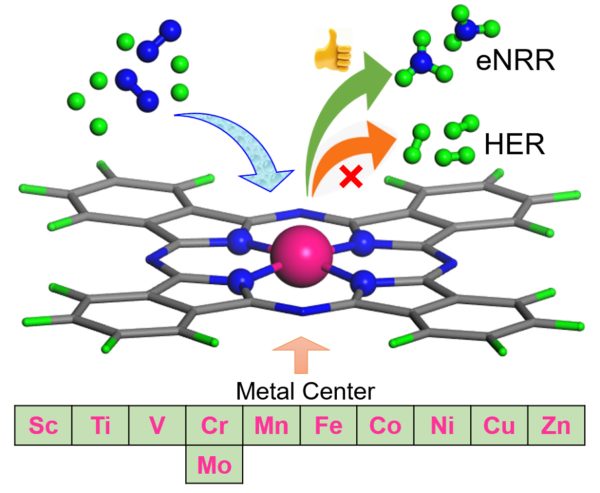 SRM Univeristy-AP is proud to announce that Prof. Ranjit Thapa, Department of Physics, has obtained a prestigious SERB-DST grant of Rs. 32 lakhs for a period of three years for his project, “Design Principle of Single Atom Catalyst for Nitrogen Fixation over HER: Energy Parameter, Electronic Descriptor and Database”.
SRM Univeristy-AP is proud to announce that Prof. Ranjit Thapa, Department of Physics, has obtained a prestigious SERB-DST grant of Rs. 32 lakhs for a period of three years for his project, “Design Principle of Single Atom Catalyst for Nitrogen Fixation over HER: Energy Parameter, Electronic Descriptor and Database”.
Ammonia (NH3) is the prime source of fertilizers and an important carrier of energy too. Ammonia can be stored in its chemical form for a long and it is easy to transport. So now researchers are looking forward to using ammonia in place of hydrogen as an energy source. But the production of ammonia with existing techniques needs more energy compared to the energy it stored in its chemical bond. So, an alternative process that is environmentally friendly and cost-effective is needed to be in place.
In 2019 the global production capacity of ammonia is 235 million metric tons and will increase to 290 million metric tons by 2030. The importance of ammonia is due to its application in broad and diverse fields, such as fertilizers, textiles, pharmaceuticals, and is a carbon-free energy carrier. The Haber-Bosch process is used for the synthesis of ammonia (NH3) from N2 and H2 using Fe based catalyst. But the process emits carbon dioxide (CO2) (1.5 tons of CO2/tons of NH3 production) requires high pressure and temperature and consumes around 2% of the global supply of energy. Electrocatalytic N2 fixation (N2 + 6H+ + 6e− → 2NH3) showed great potential due to the possible use of atmospheric nitrogen and hydrogen derived from water through electrolysis and in mild conditions. However, the slow kinetics of N2 adsorption, splitting of the strong N≡N bond are the challenges for the electrocatalytic NRR process. In the electrocatalytic NRR process, the fast reaction kinetics of hydrogen evolution reaction is the greatest obstacle. To solve these challenges, the search for various types of catalysts is on the roll.
To date, trial and error methods have been used to synthesize the catalysts for the electrocatalytic NRR process. Thanks to the rapid development of density functional theory-based computational methods, the intermediate steps during NRR can be identified at the atomic level, the underlying principles can be understood, and a large space of catalysts can be checked for efficient NRR within a limited time. Without understanding the correct electronic structure of SAC and its correlation with the overpotential of NRR and defining the correct energy parameter to define “NRR over HER” and “N2 binding over H binding free energy”, we can never design the best catalyst cost-effectively. We will address these problems through this project’s objectives.
The project will help to design the best single-atom catalyst for the reduction of nitrogen (from the air) through the electrocatalytic process and convert it into ammonia. The designed catalyst can be synthesis by the industry and can be used for NRR.
This project will help a step forward towards more ammonia production for the uses in the agriculture sector, energy sector, and related sector.
- Published in Departmental News, News, Physics News
Advanced research on secure transmission of medical images
 SRM University-AP promotes translational research that can add value to society making lives better. Following the tradition, Dr Priyanka Singh, Assistant Professor and her PhD student Ms Jyothsna Devi from the Department of Computer Science and Engineering have published their recent research work “Region-based Hybrid Medical Image Watermarking Scheme for Robust and Secured Transmission in IoMT” in ‘IEEE Access journal’ (Impact Factor of 3.36).
SRM University-AP promotes translational research that can add value to society making lives better. Following the tradition, Dr Priyanka Singh, Assistant Professor and her PhD student Ms Jyothsna Devi from the Department of Computer Science and Engineering have published their recent research work “Region-based Hybrid Medical Image Watermarking Scheme for Robust and Secured Transmission in IoMT” in ‘IEEE Access journal’ (Impact Factor of 3.36).
Dr Priyanka’s research focuses on the healthcare industry that is rapidly transforming medical images into ones that operate in real-time environments (IoMT, IoT, Cloud and so on). The research is proposed to address security and integrity issues in medical image transmission on IoT and edge healthcare applications with a lossless reversible region-based MIW scheme.
In this era of technological advancement, medical images and patient information are widely transmitted through a public transmission channel on the Internet of Medical Things (IoMT) applications. While sharing medical images or electronic patient records (EPR) through a public network, they can get tampered with or manipulated, leading to the wrong diagnosis by the medical consultants. Confidentiality of the patient record is also a major concern. Thus, it is very important to ensure the authenticity, authorisation, integrity, and confidentiality of the information during transmission.
ABSTRACT:
With the growth in Internet and digital technology, the Internet of Medical Things (IoMT) and Telemedicine have become buzzwords in healthcare. A large number of medical images and information are shared through a public network in these applications. This paper proposes a region-based hybrid Medical Image Watermarking (MIW) scheme to ensure the authenticity, authorisation, integrity, and confidentiality of the medical images transmitted through a public network in IoMT. In the proposed scheme, the medical image is segmented into Region of Interest (RoI) and Region of Non-Interest (RoNI).
RoI tamper detection and recovery bits are embedded in RoI to ensure the integrity of the medical image. RoI is watermarked using adaptive Least Significant Bit (LSB) substitution with respect to the hiding capacity map for higher RoI imperceptibility and accuracy in tamper detection and recovery. Electronic Patient Record (EPR) is compressed using Huffman coding and encrypted using a pseudo-random key (secret key) to provide higher confidentiality and payload. Encrypted EPR, QR code of hospital logo and RoI recovery bits are embedded in RoNI using Discrete Wavelet Transform-Singular Value Decomposition (DWT-SVD) hybrid transforms to achieve a robust watermark.
The proposed scheme is tested under various geometric and non-geometric attacks such as filtering, compression, rotation, salt and pepper noise and shearing. The evaluation results demonstrate that the proposed scheme has high imperceptibility, robustness, security, payload, tamper detection, and recovery accuracy under image processing attacks. Therefore, the proposed scheme can be used in the transmission of medical images and EPR in IoMT. The relevance of the proposed scheme is established by its superior performance in comparison to some of the popular existing schemes.
- Published in Computer Science News, CSE NEWS, News, Research News
Dr Aqsa Agha receives the South Asia Public Health Fellowship
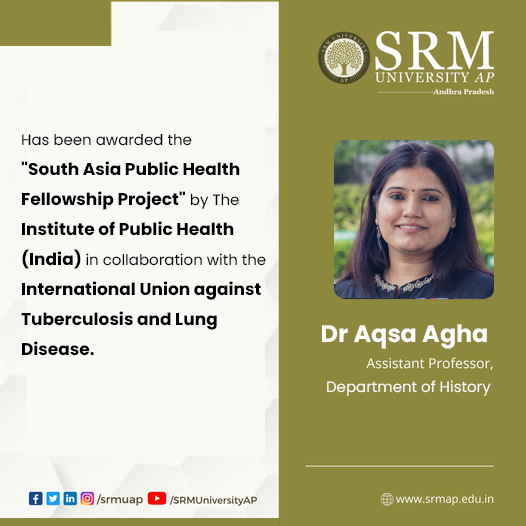 Dr Aqsa Agha, Assistant Professor, the Department of History, has been awarded the South Asia Public Health Fellowship Project by The Institute of Public Health (India) in collaboration with the International Union against Tuberculosis and Lung Disease. As the South Asia Public Health Fellow-India, Dr Agha is expected to conduct research on the ethics of the tobacco industry and submit the report over a period of 8 months, i.e. from December 01, 2021, to July 31, 2022. She has been granted an amount of USD 6660 to carry out the project.
Dr Aqsa Agha, Assistant Professor, the Department of History, has been awarded the South Asia Public Health Fellowship Project by The Institute of Public Health (India) in collaboration with the International Union against Tuberculosis and Lung Disease. As the South Asia Public Health Fellow-India, Dr Agha is expected to conduct research on the ethics of the tobacco industry and submit the report over a period of 8 months, i.e. from December 01, 2021, to July 31, 2022. She has been granted an amount of USD 6660 to carry out the project.
Along with producing a quality case study on India focusing on industry interferences promoting the tobacco epidemic and undermining public policies related to tobacco control, the project entails drafting the regional report on South Asia. It will bring together country-level case studies and implications between December-May, 2022, engaging in the dissemination of the country-level case studies with relevant stakeholders in June-July 2022.
Article 5.3 of the World Health Organization Framework Convention on Tobacco Control (WHO FCTC) acts as a treaty for ratified countries to protect their citizens against the commercial and vested interests of the tobacco industry as per guidelines laid down in the said article. Countries of South Asia, including India, have signed and fully ratified this treaty in the early 2000s. However, the lack of robust national policies and continued influence of the tobacco industry perpetuates the tobacco epidemic, as established in the available literature. Given each country’s mandate to protect the health of its citizens, there is a growing need to understand issues of tobacco industry interferences that undermine public policies meant to protect its population. The South Asian Public Health Fellowship is an initiative to generate knowledge regarding issues of tobacco industry interference not only in India but in other countries of South Asia (i.e., Nepal, Sri Lanka and Bangladesh) to better understand such issues from a regional perspective.
Dr Aqsa Agha holds a PhD in History from the Centre for Historical Studies, JNU. She is also the Project Head of Unnat Bharat Abhiyan at SRM University-AP. Before joining SRM University-AP, Dr Agha was a Consultant with Partners in Change, New Delhi and prepared a report titled “Status of Corporate Responsibility in India, 2020”, focusing on corporate responsibility and ethical business practices. Prior to that, she worked as a Research Officer for National Research Study on Human Trafficking in India at TISS, Mumbai. Before TISS, she worked with the Human Rights Defenders’ Alert- India on human rights violations on the India-Bangladesh border in West Bengal. Along with teaching, she has consulted with organisations, including the Centre for Equity Studies, New Delhi, where she conducted sessions with grassroots activists to effectively observe, analyse and document reality through participatory research. Her broader research interest lies in historical processes and their impact on the social locations of class, caste and gender.
- Published in Faculty Achievements, History Current Happenings, History News, News, Research News
Dr Azizuddin Khan deliberated upon Medication Adherence
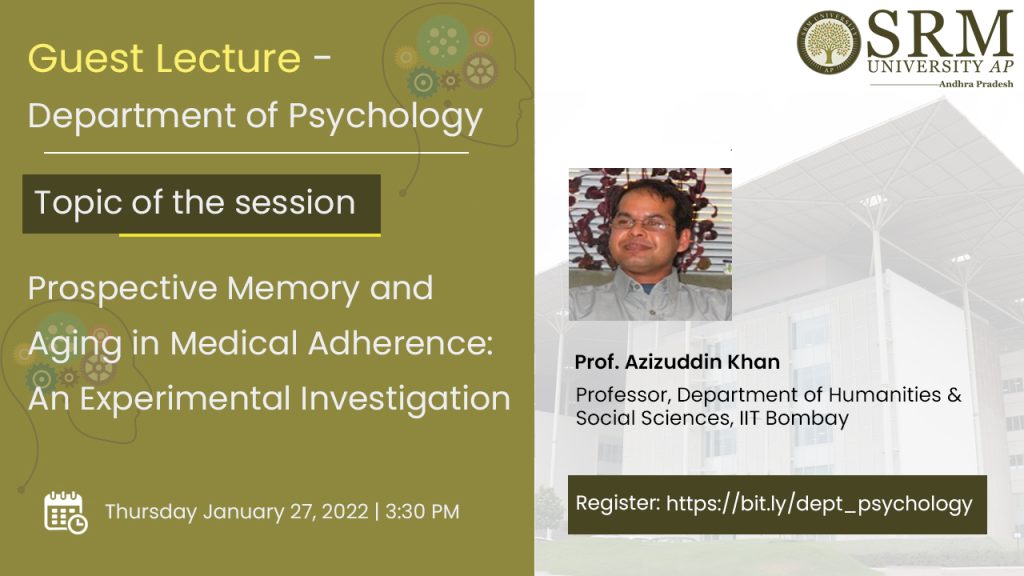 Department of Psychology, SRM University, AP-Andhra Pradesh organised a guest lecture on the topic “Prospective Memory and Aging in Medication Adherence: An Experimental Investigation” on January 27, 2022, from 3:30 to 4:30 pm. Dr Azizuddin Khan, Professor, Department of Humanities and Social Sciences, Indian Institute of Technology-Mumbai, attended the session as the eminent speaker.
Department of Psychology, SRM University, AP-Andhra Pradesh organised a guest lecture on the topic “Prospective Memory and Aging in Medication Adherence: An Experimental Investigation” on January 27, 2022, from 3:30 to 4:30 pm. Dr Azizuddin Khan, Professor, Department of Humanities and Social Sciences, Indian Institute of Technology-Mumbai, attended the session as the eminent speaker.
The session started with a brief introduction of Prof Khan by Mrs Ayesha Parveen Haroon, Lecturer, Department of Psychology. Thereafter, Prof Khan delivered his lecture wherein he deliberated upon the medical adherence, aging and prospective memory as well as the factors affecting medical adherence. Specifically, he emphasised the effect of memory and intellectual abilities on medical adherence. Following Prof Khan’s presentation, the questions raised by the audience were communicated to Prof Khan by Dr Aehsan Ahmad Dar, Assistant Professor, Department of Psychology. Prof Khan provided interesting insights on the questions raised. The programme ended with the vote of thanks delivered by Dr Ninad Patwardhan, Assistant Professor and Faculty Coordinator, Department of Psychology.
- Published in News, Psychology News
Budget Panel Discussion 2022-23
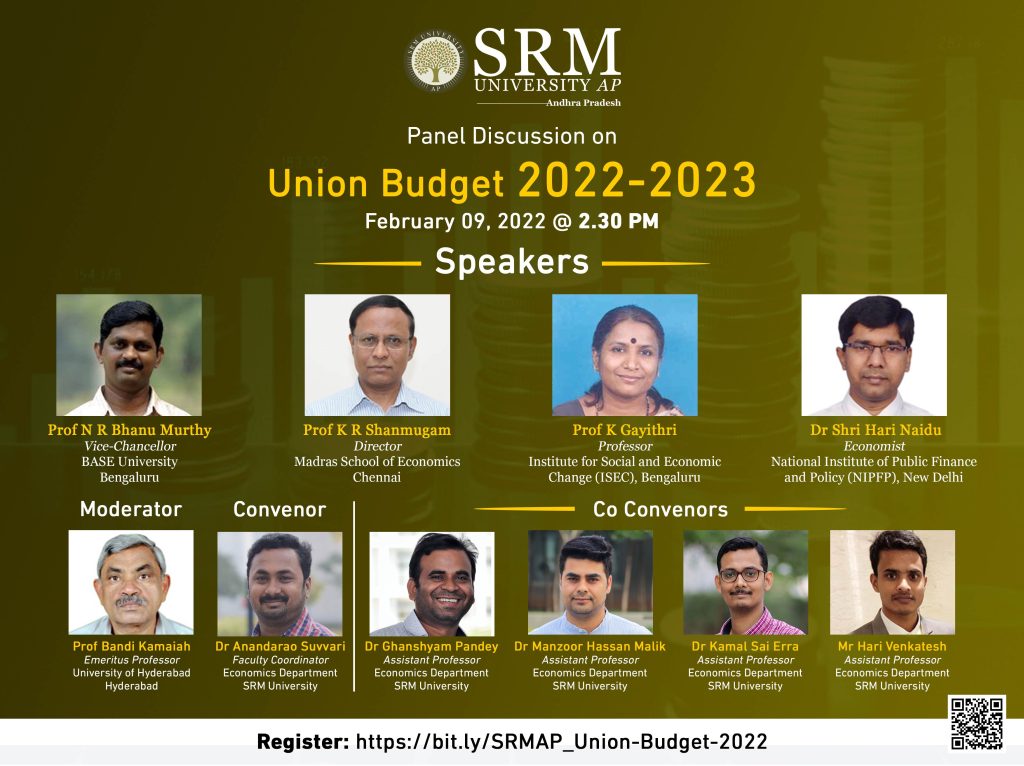 The Department of Economics of SRM University-AP, Andhra Pradesh, conducted a Panel Discussion on February 09, 2022, for the much needed and relevant in-depth analysis of the Union Budget proposed by the Finance Minister in the parliament on February 01, 2022.
The Department of Economics of SRM University-AP, Andhra Pradesh, conducted a Panel Discussion on February 09, 2022, for the much needed and relevant in-depth analysis of the Union Budget proposed by the Finance Minister in the parliament on February 01, 2022.
Professor Bandi Kamaiah was the moderator of the event, and Dr Anandarao Suvvari, the faculty coordinator of the Department of Economics in the University, organised this discussion, inviting four eminent public finance economists of India, Prof N R Bhanu Murthy, Vice-Chancellor, BASE University, Bengaluru; Prof K R Shanmugam, Director, Madras School of Economics, Chennai; Prof K Gayathri, Professor, Institute for Social and Economic Change (ISEC), Bengaluru; Dr Shri Hari Naidu, Economist, National Institute of Public Finance and Policy (NIPFP), New Delhi. The co-convenors of the event were Dr Ghanshyam Pandey, Dr Manzoor Hassan Malik, Dr Kamal Sai Erra, Dr Hari Venkatesh from the Department of Economics SRM-AP.
The discussion started with a brief overview and essence of the Union budget by Dr Anandarao Suvvari, followed by Prof Bandi Kamaiah. Then first panellist Prof N R Bhanu Murthy, who our Indian Finance Minister also quoted, spoke about how the current budget is a continuation of the previous budget and emphasised more on the capital expenditure, which is the route to growth. He highlighted that the government should bring efficiency in public expenditure and expressed that the public policymakers side-lined the public debt number to GDP ratio at both central and state levels. An issue identified by Prof Murthy was bringing in many commodities under the customs tariff line and how doing this will have a negative impact on the exports. Further, he mentioned the ignorance towards the health and education sectors by a reduction in the allocation of expenditure for the same.
The second panellist Prof K R Shanmugam, gave a very detailed look at the budget, sector by sector, pointing out the benefits and the concerns related to each of them. He gave us a brief look at how the Indian economy has been doing for the past few years and gave an analysis taking this into consideration and stated that the budget had provided necessary fiscal stimuli through an increase in capital expenditure for the revival of the economy.
The third panellist Prof K Gayathri highlighted the philosophy of policy implications of budget and the need for a continuous process for analysing it. She also focused on the need for scientificity for estimates and the need for a sustainable approach for the budget. She pointed out that the current budget was future-looking in line with the vision for India 100 and that it put thorough emphasis on capacity building inclusive development by involving all stakeholders and modern infrastructure while expressing concern over effective implementation of policies.
The final panellist, Dr Shri Hari Naidu, discussed the revenue side of the budget thoroughly while focusing on the new taxation regime, other and legitimising crypto assets and digital Indian currency. In addition to this, Dr Naidu commented on the budget that the tax GDP ratio has been stagnant for the past two decades also, it has not been addressed in the budget, and despite the fact that there were a lot of tax reforms, the tax bases needed to be expanded.
After individual reviews by the panellists, questions posed by the students and the co-convenors were answered, followed by an interactive and engaging discussion among panellists, moderator, convenor and co-convenors on various issues spanning from the way of analysing the budget, trade-offs between debt and capital expenditure, debt sustainability, control mechanisms, the process of allocation, outcome evaluation or impact of the budget and the need for reality and effectiveness of planned budget on the ground level.
The session, after a thorough discussion on the union budget, was concluded by a vote of thanks proposed by Asst. Prof. Dr Hari Venkatesh to the esteemed panellists, moderator, convenor, co-convenors and all the people who made this session successful for contributing their precious time and valued efforts.
- Published in Departmental News, Economics Current Happenings, Economics News, News
SRM University-AP publishes as the lead author among 21 co-authors from 13 countries
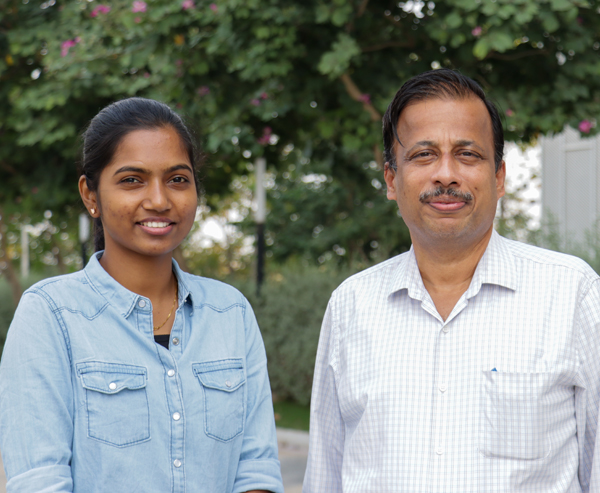 “Progress in Alternative Strategies to Combat Antimicrobial Resistance: Focus on Antibiotics” is a paper authored by Prof Jayaseelan Murugaiyan, Professor & Head, Department of Biological Sciences at SRM University-AP and his research scholar Ms Saranya Adukkadukkam, in Antibiotics Journal, having an impact factor of 4.639. It is a remarkable achievement that our university served as the first and the corresponding authors of this paper published in association with “Global AMR Insights Ambassadors Network”. A total of 21 co-authors from 13 countries (India, UK, France, The Netherlands, Switzerland, Italy, Spain, Ukraine, Lebanon, Egypt, Uganda, Bangladesh, and Nigeria) and six Indian universities (including SRM AP) participated in this work.
“Progress in Alternative Strategies to Combat Antimicrobial Resistance: Focus on Antibiotics” is a paper authored by Prof Jayaseelan Murugaiyan, Professor & Head, Department of Biological Sciences at SRM University-AP and his research scholar Ms Saranya Adukkadukkam, in Antibiotics Journal, having an impact factor of 4.639. It is a remarkable achievement that our university served as the first and the corresponding authors of this paper published in association with “Global AMR Insights Ambassadors Network”. A total of 21 co-authors from 13 countries (India, UK, France, The Netherlands, Switzerland, Italy, Spain, Ukraine, Lebanon, Egypt, Uganda, Bangladesh, and Nigeria) and six Indian universities (including SRM AP) participated in this work.
Antimicrobial resistance (AMR) – the ability of microorganisms to survive antimicrobials – is a global healthcare concern. AMR contributes to 1.27 million deaths among the 4.95 million deaths associated with bacterial AMR. If no control measures are taken, it is estimated that by 2050, it will claim the lives of 300 million people. The rise of these “superbug bacteria’s” – means that trivial medical interventions will soon become once again high-risk since no efficient antimicrobial chemotherapy is available. It is, therefore, crucial to understand the current situation and identify alternatives to combat the emergence and spread of antimicrobial resistance. This paper comprehensively discusses the alternative approaches that can be effectively utilised to combat AMR and, at the same time, without inducing further resistance among the pathogens. The paper has great social implications in making society aware of the scenario and encouraging the researchers to focus on alternative strategies to combat AMR.
Abstract of the paper: Antibiotic resistance, and, in a broader perspective, antimicrobial resistance (AMR), continues to evolve and spread beyond all boundaries. As a result, infectious diseases have become more challenging or even impossible to treat, leading to an increase in morbidity and mortality. Despite the failure of conventional, traditional antimicrobial therapy, in the past two decades, no novel class of antibiotics has been introduced. Consequently, several novel alternative strategies to combat these (multi-) drug-resistant infectious microorganisms have been identified. The purpose of this review is to gather and consider the strategies that are being applied or proposed as potential alternatives to traditional antibiotics. These strategies include combination therapy, techniques that target the enzymes or proteins responsible for antimicrobial resistance, resistant bacteria, drug delivery systems, physicochemical methods, and unconventional techniques, including the CRISPR-Cas system. These alternative strategies may have the potential to change the treatment of multi-drug-resistant pathogens in human clinical settings.
Global AMR Insight Ambassador Network: AMR Insights, an international network-based organisation interacting with professionals around the globe: in Human and Veterinary Health, Agri-food and Environment, was set up in 2017 following an in-depth feasibility study towards a new information platform on AMR. It mainly focuses on informing, educating and connecting people with the aim to curb antimicrobial resistance. Prof Jayaseelan Murugaiyan and Ms Saranya Adukkadukkam are members of the Global AMR Insights Ambassador Network.
Ms Saranya Adukkadukkam, the co-author from SRM AP says:
The guidance of Prof Jayaseelan Murugaiyan is the pillar of my research. His support and passion for research always encourage me. He gives importance to translational research and motivates me to stand unique in the field. He shows me a path where I can serve the people through research. Foreseeing my future as a scientist, he guides me to more opportunities to collaborate with international scientists. I feel proud of my mentor Prof Jayaseelan Murugaiyan for letting me fly. Also, I thank SRM University-AP for providing generous fellowship, excellent research facilities and ambience to carry out the research.
- Published in Biology News, Departmental News, News, Research News
Vision-based fall detection AI
Human-like care is difficult to replicate. Due to the lack of a reliable vision-based fall detection AI, it is often more effective to assign a lot of manpower towards vision-based detections that have not been efficiently implemented.
Ms Inturi Anita Rani, Research Scholar in the Department of Computer Science Engineering, working with her supervisor, Dr V. M. Manikandan, has worked on a paper titled, “A Novel Vision-Based Fall Detection Scheme using Keypoints of Human-Skeleton with Long Short-term Memory Network” in the Arabian Journal for Science and Engineering published by Springer with an Impact Factor of 2.33.
Abstract of the research:
Humans are skilled at visually recognizing and classifying actions in videos, but it’s tough to automate this process. Human action detection in videos is useful in applications like automated surveillance, assisted living, human-computer interaction, content-based video retrieval, and video summarization. The ability to recognize atomic actions like “walking,” “bending,” and “falling” is critical for activity analysis when monitoring elderly people’s daily activities. Our paper presents a new promising solution for fall detection using vision-based approaches. In this approach, we analyse the human joint points which are the prime motion indicators. A set of keypoints of the subject are acquired by applying the AlphaPose pre-trained network. These keypoints are inferred to be the joint points of the subject. The acquired keypoints are processed through a framework of convolutional neural network (CNN) layers. Here, the spatial correlation of the keypoints is analysed. The long-term dependencies are then preserved with the help of long short-term memory (LSTM) architecture. Our system detects five types of falls and six types of daily living activities. We used the UP-FALL detection dataset for validating our fall detection system and achieved commendable results when compared to the state-of-the-art approaches. For comparison, we employed the OpenPose network for keypoint detection. It is inferred from the results that the AlphaPose network is more precise in keypoint detection.
About the research paper:
In this paper, the author proposes a vision-based system that is capable of detecting various types of falls accurately through video processing with the help of a machine learning approach.
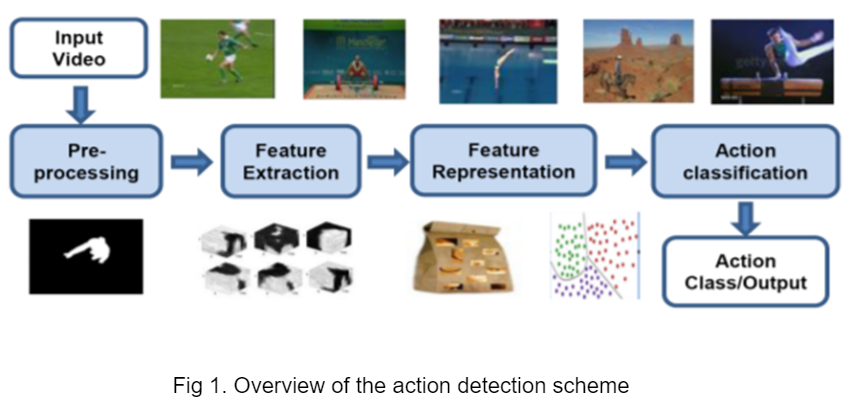
Implementation of the research:
The proposed scheme can be used to monitor the activity of elderly people and if any unusual falls happen, the information can be shared with caretakers to ensure emergency services.
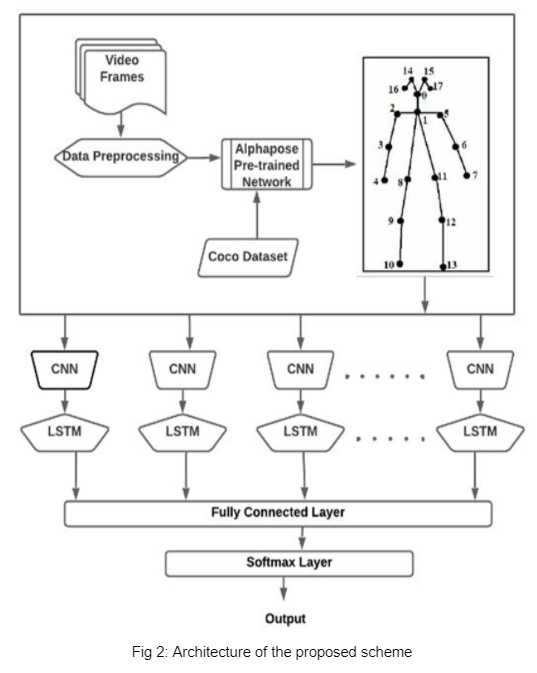
- Published in CSE NEWS, Departmental News, News, Research News
Tenancy and Credit: Exploring Facts below the Crust in AP
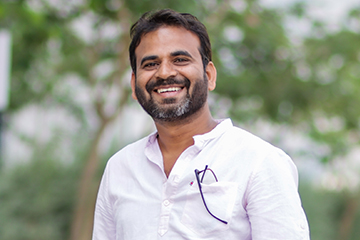 SRM University-AP is proud to announce that Dr Ghanshyam Kumar Pandey, Department of Economics, has received the prestigious NABARD (National Bank for Agriculture and Rural Development) grant of Rs 14.85 lacs for a duration of 10 months of active research on “Tenancy and Credit: Exploring Facts below the Crust in AP”.
SRM University-AP is proud to announce that Dr Ghanshyam Kumar Pandey, Department of Economics, has received the prestigious NABARD (National Bank for Agriculture and Rural Development) grant of Rs 14.85 lacs for a duration of 10 months of active research on “Tenancy and Credit: Exploring Facts below the Crust in AP”.
About the Research
The study will attempt to identify different possible sources of credit of agriculture households in the Guntur district of AP and then an analysis of the impact at the macro level will be carried out. The role of self-help groups and microfinance on agriculture and livelihood will be one important component of this analysis. Transaction cost, cascading effect, and loan waiver impact will be estimated across tenant and owner cultivators, and social groups.
The study will help to understand the improvement in the life of tenants due to the adoption of the ‘Model Tenancy Act’ and provide feedback on the Tenancy Certificate introduced in AP for enabling farmers to access bank/formal credit and whether the formation of JLGs has led to increase in the credit availability to tenants or not.
The project will help understand the sociological impact of economic decisions by the governance and help direct policies to more beneficial outcomes especially in terms of Tenancy and Credit.
- Published in Departmental News, Economics Current Happenings, Economics News, News
Molybdenum as the next-generation catalyst
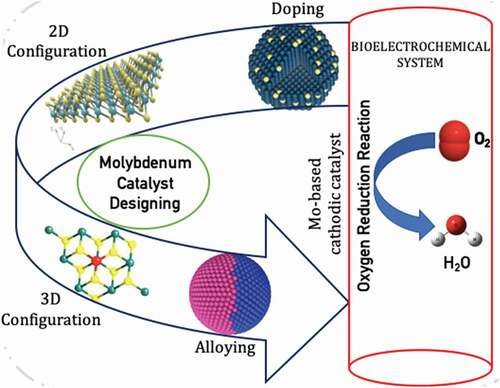 The Department of Environmental Science is proud to announce that Dr Lakhveer Singh has published his paper titled, “Progressions in cathodic catalysts for oxygen reduction and hydrogen evolution in bioelectrochemical systems: Molybdenum as the next-generation catalyst” in a prestigious journal Catalysis Review with a high Impact Factor of 20.21.
The Department of Environmental Science is proud to announce that Dr Lakhveer Singh has published his paper titled, “Progressions in cathodic catalysts for oxygen reduction and hydrogen evolution in bioelectrochemical systems: Molybdenum as the next-generation catalyst” in a prestigious journal Catalysis Review with a high Impact Factor of 20.21.
The article is published in collaboration with NCL Pune, Hong Kong Baptist University, and VITO-Flemish Institute for Technological Research, Belgium.
Abstract of the Research
Oxygen reduction reactions (ORR) are unanimously a key factor of system performances in bioelectrochemical systems (BESs), low-temperature fuel cells, and generally in several electro-chemical platforms. Platinum (Pt)-based catalyst is the finest electrocatalyst for ORR in BESs; however, it is constrained by its low abundance, high price, and poor catalytic durability in an electrochemical setup for cathodic reaction kinetics. Molybdenum (Mo) with its multi-dimensional form as 2D and 3D layers and synergistic combination with other non-metals offers prospects of extraordinary performance as a low-cost metal-based ORR catalyst over the Pt in delivering enhanced ORR potential.
About the Research
This article throws light on the current requirements of sturdier catalyst material and thus provides a comprehensive review of the continuing efforts in exploring the possibility of Mo as a low-cost metal-based ORR catalyst for sustainable energy production.
Mo-based catalysts have been now widely used for their applications in environmental and energy-based catalysis due to the low cost of Mo, high stability, and excellent activity.
In the future, Dr Lakhveer Singh and his collaborators are working on overcoming limitations to fabricate durable, stable, and catalytically active micro/nanoscale two-dimensional MoS2-based cathodes at an industrial scale, commercial bioelectrochemical devices can be obtainable in future.
- Published in Departmental News, ENVS News, News, Research News
Security Framework using Blockchain Technology
The Department of Computer Science Engineering is proud to announce that Dr Sriramulu Bojjagani has published a paper titled “Blockchain-Based Security Framework for Sharing Digital Images using Reversible Data Hiding and Encryption” in the journal Multimedia Tools and Applications (MTAP) having an impact factor of 2.757.
The paper is published in collaboration with D.R Denslin Brabin from the Department of Computer Science and Engineering, DMI College of Engineering, Tamil Nadu and Christo Ananth from the Department of Electronics and Communication Engineering, St. Mother Theresa Engineering College, Tamil Nadu.
Abstract of the Research
Security is an important issue in current and next-generation networks. Blockchain will be an appropriate technology for securely sharing information in next-generation networks. Digital images are the prime medium attacked by cyber attackers. In this paper, a blockchain-based security framework is proposed for sharing digital images in a multi-user environment. The proposed framework uses reversible data hiding and encryption as component techniques. A novel high-capacity reversible data hiding scheme is also proposed to protect digital images. Reversible data hiding in combination with encryption protects the confidentiality, integrity and authentication of digital images. In the proposed technique, the digital image is compressed first to create room for data hiding, then the user signature is embedded; afterwards, the whole image is encrypted. For compression, JPEG lossy compression is used to create high capacity. For encryption, any symmetric block cipher or stream cipher can be used. Experimental results show that the proposed blockchain-based framework provides high security and the proposed reversible data hiding scheme provides high capacity and image quality.

Fig 1: The process of encoding during reversible data hiding
Dr Sriramulu Bojjagani also intends to work on the development of block-chain based solutions to intelligent transport systems and on addressing the challenges of security issues involved in connected and autonomous vehicles.
- Published in CSE NEWS, Departmental News, News, Research News

